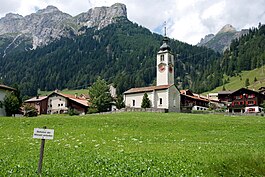Sufers
Sufers | |
|---|---|
 | |
 Coat of arms | |
show Location of Sufers | |
 Sufers | |
| Coordinates: 46°34′N 9°22′E / 46.567°N 9.367°ECoordinates: 46°34′N 9°22′E / 46.567°N 9.367°E | |
| Country | Switzerland |
| Canton | Graubünden |
| District | Viamala |
| Government | |
| • Mayor | Thomas Lechner |
| Area | |
| • Total | 34.62 km2 (13.37 sq mi) |
| Elevation | 1,430 m (4,690 ft) |
| Population (2018-12-31)[2] | |
| • Total | 144 |
| • Density | 4.2/km2 (11/sq mi) |
| Time zone | UTC+01:00 (Central European Time) |
| • Summer (DST) | UTC+02:00 (Central European Summer Time) |
| Postal code(s) | 7434 |
| SFOS number | 3695 |
| Surrounded by | Andeer, Casti-Wergenstein, Ferrera, Madesimo (IT-SO), Safien, Splügen |
| Website | www SFSO statistics |
Sufers (Romansh: Sur) is a municipality in the Viamala Region in the Swiss canton of Graubünden.
History[]
Sufers is first mentioned in 831 as Subere.[3]
Geography[]

Sufers has an area, as of 2006, of 34.6 km2 (13.4 sq mi). Of this area, 13.4% is used for agricultural purposes, while 23.8% is forested. Of the rest of the land, 1.2% is settled (buildings or roads) and the remainder (61.6%) is non-productive (rivers, glaciers or mountains).[4]
Before 2017, the municipality was located in the Rheinwald sub-district, of the Hinterrhein district, after 2017 it was part of the Viamala Region.[5] It is a Haufendorf (an irregular, unplanned and quite closely packed village, built around a central square).
A dam on the Hinterrhein river was built in 1962 and forms the reservoir Sufnersee.
Demographics[]
Sufers has a population (as of 31 December 2019) of 145.[6] As of 2008, 3.1% of the population was made up of foreign nationals. Over the last 10 years the population has decreased at a rate of -6.6%.[4]
As of 2000, the gender distribution of the population was 52.0% male and 48.0% female.[7] The age distribution, as of 2000, in Sufers is; 14 people or 12.2% of the population are between 0 and 9 years old. 11 people or 9.6% are 10 to 14, and 4 people or 3.5% are 15 to 19. Of the adult population, 11 people or 9.6% of the population are between 20 and 29 years old. 18 people or 15.7% are 30 to 39, 10 people or 8.7% are 40 to 49, and 17 people or 14.8% are 50 to 59. The senior population distribution is 12 people or 10.4% of the population are between 60 and 69 years old, 10 people or 8.7% are 70 to 79, there are 8 people or 7.0% who are 80 to 89.[8]
In the 2007 federal election the most popular party was the SVP which received 57.3% of the vote. The next two most popular parties were the FDP (19.3%) and the CVP (2.1%).[4]
In Sufers about 77.9% of the population (between age 25-64) have completed either non-mandatory upper secondary education or additional higher education (either university or a Fachhochschule).[4]
Sufers has an unemployment rate of 0.29%. As of 2005, there were 26 people employed in the primary economic sector and about 9 businesses involved in this sector. 12 people are employed in the secondary sector and there are 3 businesses in this sector. 27 people are employed in the tertiary sector, with 7 businesses in this sector.[4]
The historical population is given in the following table:[3]
| year | population |
|---|---|
| 1690 | 186 |
| 1807 | 224 |
| 1850 | 184 |
| 1900 | 104 |
| 1950 | 124 |
| 2000 | 115 |
| 2010 | 126 |
Languages[]
Most of the population (as of 2000) speaks German (91.3%), with Serbo-Croatian being second most common ( 4.3%) and Romansh being third ( 3.5%).[4]
| Languages in Sufers | ||||||
| Languages | Census 1980 | Census 1990 | Census 2000 | |||
| Number | Percent | Number | Percent | Number | Percent | |
| German | 105 | 92.11% | 104 | 93.69% | 105 | 91.30% |
| Romansh | 3 | 2.63% | 1 | 0.90% | 4 | 3.48% |
| Population | 114 | 100% | 111 | 100% | 115 | 100% |
References[]
- ^ Jump up to: a b "Arealstatistik Standard - Gemeinden nach 4 Hauptbereichen". Federal Statistical Office. Retrieved 13 January 2019.
- ^ "Ständige Wohnbevölkerung nach Staatsangehörigkeitskategorie Geschlecht und Gemeinde; Provisorische Jahresergebnisse; 2018". Federal Statistical Office. 9 April 2019. Retrieved 11 April 2019.
- ^ Jump up to: a b Sufers in German, French and Italian in the online Historical Dictionary of Switzerland.
- ^ Jump up to: a b c d e f Swiss Federal Statistical Office accessed 06-Oct-2009
- ^ Swiss Federal Statistical Office - Amtliches Gemeindeverzeichnis der Schweiz - Mutationsmeldungen 2016 accessed 16 February 2017
- ^ "Ständige und nichtständige Wohnbevölkerung nach institutionellen Gliederungen, Geburtsort und Staatsangehörigkeit". bfs.admin.ch (in German). Swiss Federal Statistical Office - STAT-TAB. 31 December 2019. Retrieved 6 October 2020.
- ^ Graubunden in Numbers Archived 2009-09-24 at the Wayback Machine (in German) accessed 21 September 2009
- ^ Graubunden Population Statistics Archived 2009-08-27 at the Wayback Machine (in German) accessed 21 September 2009
| Wikimedia Commons has media related to Sufers. |
External links[]
- Official Web site (in German)
- Sufers in German, French and Italian in the online Historical Dictionary of Switzerland.
- Municipalities of Graubünden


